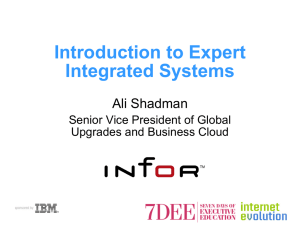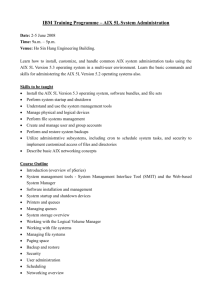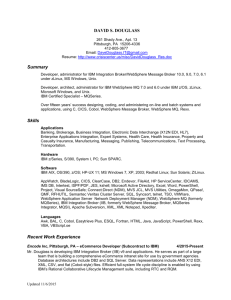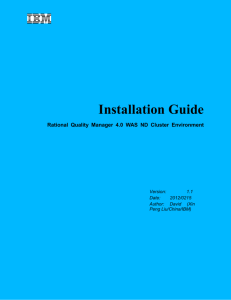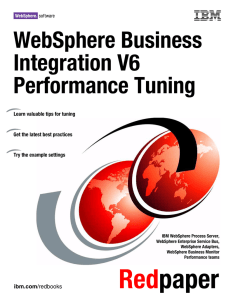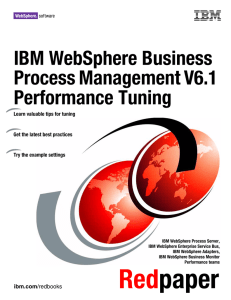david p - OpenNet
advertisement
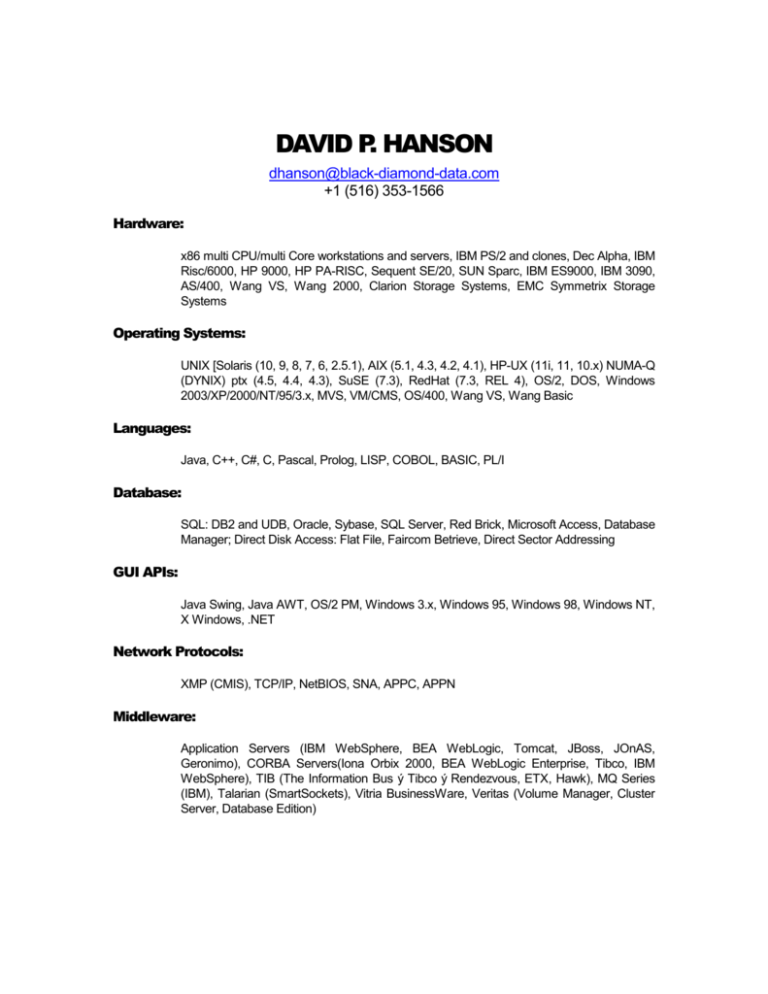
DAVID P. HANSON dhanson@black-diamond-data.com +1 (516) 353-1566 Hardware: x86 multi CPU/multi Core workstations and servers, IBM PS/2 and clones, Dec Alpha, IBM Risc/6000, HP 9000, HP PA-RISC, Sequent SE/20, SUN Sparc, IBM ES9000, IBM 3090, AS/400, Wang VS, Wang 2000, Clarion Storage Systems, EMC Symmetrix Storage Systems Operating Systems: UNIX [Solaris (10, 9, 8, 7, 6, 2.5.1), AIX (5.1, 4.3, 4.2, 4.1), HP-UX (11i, 11, 10.x) NUMA-Q (DYNIX) ptx (4.5, 4.4, 4.3), SuSE (7.3), RedHat (7.3, REL 4), OS/2, DOS, Windows 2003/XP/2000/NT/95/3.x, MVS, VM/CMS, OS/400, Wang VS, Wang Basic Languages: Java, C++, C#, C, Pascal, Prolog, LISP, COBOL, BASIC, PL/I Database: SQL: DB2 and UDB, Oracle, Sybase, SQL Server, Red Brick, Microsoft Access, Database Manager; Direct Disk Access: Flat File, Faircom Betrieve, Direct Sector Addressing GUI APIs: Java Swing, Java AWT, OS/2 PM, Windows 3.x, Windows 95, Windows 98, Windows NT, X Windows, .NET Network Protocols: XMP (CMIS), TCP/IP, NetBIOS, SNA, APPC, APPN Middleware: Application Servers (IBM WebSphere, BEA WebLogic, Tomcat, JBoss, JOnAS, Geronimo), CORBA Servers(Iona Orbix 2000, BEA WebLogic Enterprise, Tibco, IBM WebSphere), TIB (The Information Bus ý Tibco ý Rendezvous, ETX, Hawk), MQ Series (IBM), Talarian (SmartSockets), Vitria BusinessWare, Veritas (Volume Manager, Cluster Server, Database Edition) Programs: Model Driven Architecture Tool (OptimalJ), IDE (Rational Application Developer, WebSphere Studio Application Developer, Microsoft Development Environment (.NET) ý Visual Studio 2003 and 2005, Visual Age for Java, Kawa, Visual Cafe, Visual Age for C++, Visual Slick Edit), Requirements Management Tools (DOORS, Requisite Pro), UML Tools (Rational Software Architect v6 and v7, Describe, Together Control Center, Rational Rose/C++, Java, and Enterprise), Model Driven Architecture (Compuware OptimalJ),Data Modeling Tools (ER/Studio, ERWin, Prism Warehouse Manager), Development Process (SCRUM, Agile Development, Rational Unified Process, Objectory), Easy Case, Project Scheduling Tools (Time Line, Microsoft Project, Project Manager Workbench), Network Monitoring Tools (IBM LAN Server, IBM LAN Manager, IBM LAN Net View, Net View 6000, Netware, Network General Sniffer), Neural Networks WORK EXPERIENCE March 2006 to Present Intergraph Corporation TrackForce Product The initial role at Intergraph was the Product Development Manager for the IntelliWhere product set. The initial project was to move the development from Brisbane, Australia, where the product was conceived and initially developed, to a wholly owned subsidiary in Hyderabad, India. Since the successful transition of development from Australia to India, the role at Intergraph has expanded to include management of the remote development team in Hyderabad using the SCRUM methodology with elements of the Rational Unified Process (RUP), support and oversight of implementation teams, providing sales support for demonstrations, and 3rd level customer support for all IntelliWhere products. The IntelliWhere products include J2EE applications based on WebSphere along with .NET Web Services provided by underlying Intergraph GeoMedia products based on Microsoft technologies, and Windows Mobile 5 devices. Once the initial transition to India was accomplished, a Model Driven Development process integrated with elements of a Test Driven Development process was implemented. All Java development was based on the Rational IDEs (RAD and RSA) while the Microsoft development environments were based on Visual Studio 2005 then migrated to Visual Studio 2008. BI Product When a new product line moved from a prototype phase to a Product Center supported product (in January 2008), the role expanded to include Product Development Manage for the Business Intelligence for Public Safety product. This product was built on top of BusinessObjects software (including BusinessObjects Enterprise and Data Services) as a turnkey BI product designed to support the operational systems sold by Intergraph. The initial focus was on the I/CAD and I/LEADS products that were designed to support First Responders in the Computer Aided Dispatch arena and a suite of Record Management modules designed to extend the I/CAD functionality. August 2005 to February 2006 Sino-Con / Rail-Con Group Working at the CEO level, provided consulting on design and implementation issues for a Multi-media Self-help Payment System. The primary purpose of this system is to provide the capability for China United Telecommunications Corporation (China Unicom) customers to make payments from debit cards (and credit cards) to their mobile phone accounts. The systems is based on Windows based workstations in the kiosks communicating with Web Services provided by a Linux cluster based JBoss Application Server using MySQL as the datastore. Perl was used to enable some administrative tools on the Linux cluster. Worked with the Chinese development team to establish a SCRUM based development process and utilizing Compuware’s OptimalJ model driven development environment supplemented with Eclipse for the QA team. January 2004 to February 2006 Asia Payment Systems The project provided Credit Card Transaction Processing (APAYcard) with Japanese payment options for a Hong Kong based company. The environment was based on the .NET 2003 Framework utilizing Web Services, IIS, MSMQ, and SQL Server. Continue to provide support, maintenance, and ongoing development for the system. The development process was based on SCRUM with XP components. The development IDE in use for this project was Visual Studio 2003. September 2004 to July 2005 Aetna Insurance Companies Aetna Insurance is in the process of moving the entire core IT systems to a J2EE environment while maintaining the existing systems and reacting to the pressures of market influences. As part of the SSP Product domain, the project is responsible to deliver the first domain of five domains and to establish the standards for the additional four domains to follow. The specific assignment for Aetna involves integrating a Business Rules Practice into the Product Configuration requirements. The methodology used is based on RUP. The environment is based on WebSphere and DB2 on the Mainframe. June 2003 to January 2004 Titan Secure Corporation The project provides for printing of National ID Cards and Family Cards for the Saudi government through a Web based application. The National ID Cards contain a MULTOS Smart Chip and a LaserCard Optical Strip. The application is deployed on WebSphere on the mainframe with 83 sites throughout Saudi Arabia producing cards for the entire country. Persistence is provided through DB2 on the mainframe and CICS transactions through AdvantageGen. Direct involvement included requirements gathering, analysis, development project planning, Sr. Tech lead for the Middle Tier and Data Tier. May 2002 to June 2003 Gear Software, Inc. Brought in to establish a development environment in the US (primary development done in The Netherlands) and provide a licensing management capability for their end-user product. The development environments were established for Windows (98 and higher) and UNIX (Sun Solaris (Sparc and Intel), HP-UX, AIX, TRUE64, and Linux (Sparc and Intel). Extensive use of Korn and C Script scripts were used to support the UNIX/Linux build and install tools. Also incorporated a License Management file into the end-user application that allowed for a tamper-proof license file that provides for temporary trybefore-you-buy and node-locked full license. Licensing is controlled through a web application tied to a Microsoft SQL Server database. Sun Workshop was used to make some specialized enhancements to the product for Trusted Solaris. February 2002 to March 2002 Wallace, Inc. One of two senior consultant architects brought in to assist in setting up a Project Office and providing architecture to enable migration existing Web applications based on Microsoft ASP and ADO to a WebSphere environment under Linux on the mainframe. Tools were analyzed and recommended tools for Requirements Management, UML Modeling, Date Modeling, O/R Mapping, Configuration Management, and Testing Tools. Established initial Architecture guidelines for the WebSphere J2EE application environment based on Struts and utilizing JDO based on the Kodo tool. The assignment was cut short with a budget cut. (Manager reference is available.) June 2001 to February 2002 Kemper Insurance Companies One of two senior Architects for a planning effort designed to bring all of the disparate systems within Kemper into a unified process and data architecture. This was accomplished by a four person team that analyzed the current environment, proposed an ultimate architecture, proposed interim and long term solution patterns, negotiated with current projects to include all or part of the proposed ultimate architecture. The same team produced a 4-month project plan, and delivered a strategic portfolio of projects for an 18month period. Initial implementation project involved analyzing and providing an initial architecture to consolidate ‘silos of information’ from more than twenty different applications into a single customer database. The customer schema is based on a ‘Kemperized’ version of the IIA Version 4 data model. Then next set of tasks involved mapping the IIA Version 3 process model with significant Events to be published via the Enterprise Application Integration architecture utilizing Vitria and/or MQ Series. A position paper on SOAP and .NET was prepared for the CIO and presented to the Application Architecture Team for adoption. The next phase involved in implementation of one of the strategic projects of the portfolio. Responsible for managing and implementing an API for use in J2EE Java applications in a WebSphere environment. The project was managed under the Kemper customized version of RUP using the Rational Rose UML tool. The project implemented messaging using Vitria, IBM MQ Series, and JMS under a single API that hid the complexities from the application developer and allowed for ease of migration between releases and different products. Supported hardware included Windows 2000, Windows NT, Sun Solaris, IBM AIX, and OS/390. Additionally, the API involved connectivity to DB2 on the mainframe and reading or writing of messages through the API all controlled under the CICS transaction manager. The WebSphere Application Development (WSAD) product was used as the IDE. June 1999 to March 2001 AVTEC Systems, Inc. Systems Architect and Software Architect for startup developing Order Management and Trading Systems for large brokerage and market makers on Wall Street. The system is supported under Windows NT, Windows 2000, Sun Solaris, HP-UX, and IBM AIX. Tasks revolved around establishing the development environment to support a single source tree for all supported platforms, designing an Enterprise Java Beans architecture using a C++ based Corba environment (using Remote Object Method Invocation and Event Services with both Guaranteed Delivery and Reliable Multicast Publish/Subscribe Event Services), and (using Veritas products, BEA WebLogic Enterprise or IBM WebSphere, and EMC hardware) insuring a highly scaleable, redundant, and recoverable production environment. Market Data distribution is supported via Tibco Rendezvous or Talarian SmartSockets. Designed data tier to support both Oracle and Sybase. The entire system was transactional using BEA Tuxedo, IBM CICS, or IBM Encina under the application server environment. The IDE used was Visual Age for Java to do the client Java coding and Visual Slick Edit for C++. C++ coding utilized the Rogue Wave libraries for platform and database connection independence. QA efforts utilized Load Runner, Purify, and Quantify tools. Also had responsibility to create iterative development based (RUP style) development project plan in Microsoft Project. August 1998 to May 1999 CNA Insurance, Chicago, IL Project Manager for Engineering effort in a Y2K, desktop, and infrastructure rollout. Upgrading desktops to Windows 95 or Windows NT, migrating from NetWare to Windows NT Servers, and from Token Ring to Switched Ethernet. The rollout effort evolved into a support organization. Initially responsible for management of Client Engineering and eventually responsible for Infrastructure Engineering also. Tasks included development of project plan in Microsoft Project 98, status reporting, Statement of Work, initial budgetary preparation, and escalation management. January 1998 to June 1998 New Zealand DSW, Wellington, New Zealand One of three members of the Architecture Team for an EDS project for the New Zealand Department of Social Welfare in Wellington, New Zealand. Responsible for matching general requirements specified by the client in an Information Management Architecture (IMA) document and additional requirements identified through analysis to a Business Framework and Infrastructure on the server. This process identified the services necessary to support the requirements and proposed a framework for Business Object interaction. The development environment was based on BEA Iceberg (later named W3) including Tuxedo as a transaction manager. The project started out as a pure Java implementation and later included C++ on the server side for critical performance sections. The IDE used included Visual Age for Java on client UI design and Kawa for server side code. The back end databases were both Oracle on Unix and DB2 on the mainframe. Provided significant input into the iterative development project plan based on the Objectory methodology (precursor to RUP). May 1997 to January 1998 Cedel Bank, Luxembourg Senior Architect working for Tibco, Inc. on a project for Cedel Bank, Luxembourg under the management of Andersen Consulting in London, England. Responsible for design, implementation, and testing of Technical Infrastructure components including string classes, container classes, Error and Exception Services/Manager, and Encryption and Authentication Services/Manager. The environment is based on Sun Enterprise servers running Solaris and NT workstations with Oracle running on the Sun servers and DB2 on the mainframe as part of the back-office connections. The coding language was C++. Quantify and Purify was used to verify efficiency and memory usage as part of the development process. March 1997 to May 1997 Office Depot Senior Architect on project to introduce new multi-tiered client/server architecture to the production order entry systems for the combined Office Depot/Staples companies. This project was shelved shortly after the FTC denied the proposed merger between Office Depot and Staples. The project was to involve DB2 on IBM mainframes with NT servers and NT/Windows95 clients and MQ series to connect legacy systems. The programming environment was C++. September 1996 to January 1997 Wit Capital - Global Trade, Inc., New York, NY Consultant on project to design and implement a software solution to support an Internet based Discount Broker, Initial Purchase Offering, Investment Banking, and a Price Improvement Day Trading System. The system was based on Microsoft NT, was coded in C++, and involved testing modules written in Java. Rational Rose/C++ was used to provide design documentation. July 1996 to August 1997 SoftNet, Ltd., Wellington, New Zealand Principal in Internet Service Provider located in New Zealand that offers solutions for Commercial Internet applications including Web Design, Implementation, and Hosting; Internet Access; Network Security; and Application Development. Direct work involved Network Design, Web Server installation, design, and implementation using CGI, pearl scripts (Korn and C Shell), HTML, and Oracle Database/Web Server products on a Sequent SE/20 and various Windows NT machines. September 1995 to July 1996 Royal New Zealand Police, Wellington, New Zealand Application Architect - Responsibilities included: 1) Definition of the software architecture, 2) Maintenance of the architectural integrity of the software, 3) Assessment of technical risks relative to software design, 4) Propose the order and content of the successive iterations and assist in their planning, 5) Design of the system, and 6) Consult to the implementation, integration and testing teams. The topology of the system included IBM CMOS mainframe, IBM AIX, OS/2 and Windows NT workstations. The development was accomplished in an environment to allow for a single source code base to be compiled on both the OS/2 and NT environments. The software architecture was designed to comply with a CORBA implementation. Security was provided via a DCE environment. Requirement analysis and domain object specifications were accumulated in Objectory and the application design work was done with Rational Rose/C++. PVCS provided source code control. All coding was C++ based. July 1995 to September 1995 Discover Card, Chicago, IL Senior Architect brought in on a short-term assignment to save a one year development effort that lost the Senior Architect three months prior to the deadline. Responsible for implementing standards, review the architecture, apply consistent design concepts, and implement quality assurance to the project. The project did come in on time and was rolled out with no major application related problems. The environment for this project included OS/2 workstations and servers using C++ code that integrated with a TUXEDO transaction-processing environment that integrated legacy systems that had DB2 on the mainframe. . September 1994 to June 1995 Logica North America, Fort Lauderdale, FL Senior Architect - prepared eight fixed bid contract proposals. Responsible for architecting the solution, drafting technical documents, and preparing budget estimates. Projects covered diverse clients such as Lotus Development Corporation, IBM, NCCI, and IEI. Platforms covered included UNIX, OS/2, and DOS. Direct programming included work at IBM in Boca Raton on the Directory Assistance product to upgrade all components in the telephony application. January 1994 to September 1994 Florida Power and Light, Juno Beach, FL System Architect - served as the lead technical analyst for a project to move VM/CMS Focus applications to open systems architecture. A feasibility study was first produced for moving the decision support system from VM/FOCUS to 1) UNIX/FOCUS, 2) UNIX/FOCUS with SYBASE databases, and 3) Power Builder/SYBASE. Once the VM/FOCUS to UNIX/FOCUS option was chosen, a methodology for supplying operational MVS data feeds to the UNIX environment was prototyped and a group of common user written subroutines were converted from COBOL under VM/CMS to C in UNIX. The MVS data feeds included IMS and DB2 databases. C++ utilities were designed based on the Sybase CTlib library. September 1993 to January 1994 The Hay Group, Philadelphia, PA Consultant - worked in MS Windows with Power Builder front-end and Sybase on SunOS as backend database. Wrote high and low level design for a report writer to operate under both DOS Windows and on the SunOS tied to a Sybase database. Coded base classes and the reports in C++ that are tied in to user interface via Power Builder. Additionally directed Hay employee in coding the other half of the reports and brought the employee up to speed on taking over the code for future changes and enhancements. January 1993 to September 1993 IBM, Austin, TX Tech Lead - converted high level to low level design for the Start portion of LanNetView. Provided technical advice for a 4-person development team. Designed and coded Monitor Daemon in C++ to handle scheduling and file transfer through XMP of files on monitored systems. Used SOM to integrate with overall product. The code was designed to operate on OS/2, AIX, and OS/390. Scripting languages were used to tie together development utilities that included REXX for OS/2, Korn and C Shell scripts for AIX, and JCL for OS/390. 1992 to 1993 IBM, Boca Raton, FL Consultant - problem determination responsibilities for Token Ring LAN with more than 250 rings, 500 bridges, and in excess of 8,000 adapters with specialization in TCP/IP. Hands on Development of internal tools for LAN analysis in Utilization, Availability, Performance, and Capacity based on OS/2 2.0 Workstation environment. Tool development in C++ for OS/2 and AIX. Some data feeds were accessed from the DB2 mainframe database. 1991 to 1992 UPS, Ramsey, NJ Consultant - working in C, Presentation Manager, Database Manager, and NetBios for developments of an application running on a large WAN that would plan workflow within and between UPS Hub locations around the country and world. 1983 to 1991 Equitable of New York, Bala Cynwyd, PA Programming Manager - responsible for department level computer operation including hardware and software development. An internally developed application supported and expanded upon home-office supplied systems in the area of corporate owned life insurance. This system was migrated and expanded upon through moves from a Wang 2200 in BASIC to a Wang VS in COBOL, and finally downsized onto a micro LAN environment using OS/2 Workstation on a Novell LAN and an Oracle network database. Installed and maintained two interconnected LANs - one for production and one for development. Worked with SPX/IPX, NetBios, and TCP/IP protocols in configuration of LAN along with application integration. Followed structured development methodology and waterfall project management using Timeline and the project management tool. 1982 to 1983 Cardinal Data Systems, Englewood Cliffs, NJ Consultant - developed and installed a customized general ledger system for Carnegie Hall on a Wang 2200 using a 4GL product called AIMS-PLUS. 1980 to 1982 Omega Software Systems, Inc., Valley Forge, PA Vice President and principal in Software Development Company that designed and installed software for life and property casualty insurance related applications. Personally involved in development and installation of 36 systems nationally. EDUCATION Mankato State University, Mankato, MN - Bachelor of Science December 1972 to June 1975 - Major: Finance REFERENCES Available Upon Request
